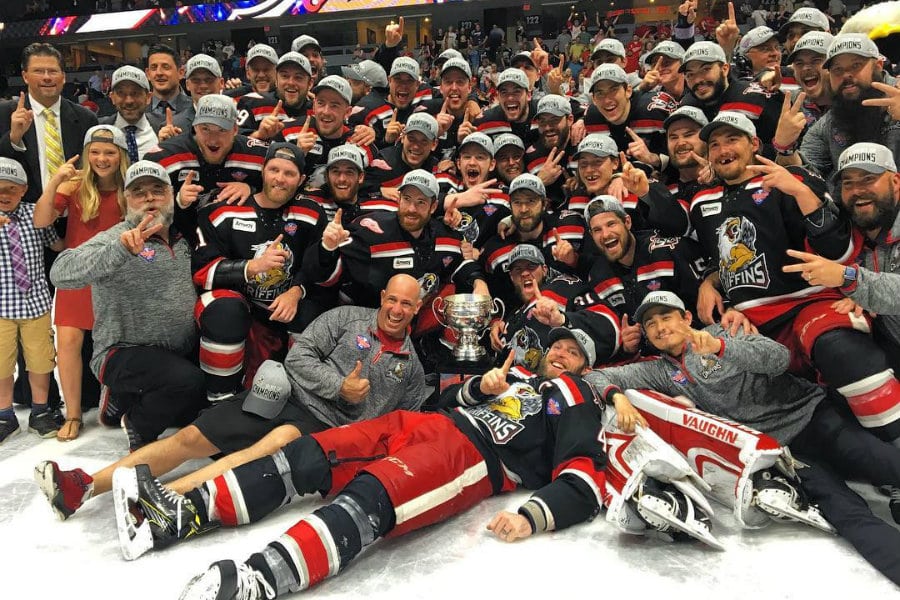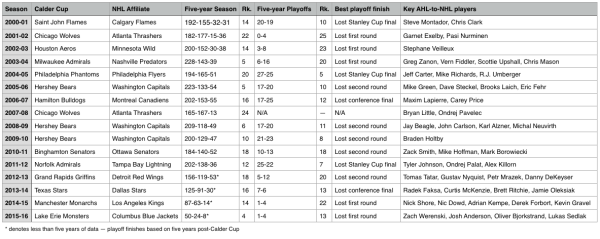
Don't assume a Calder Cup means a Stanley Cup is soon to follow
The Grand Rapids Griffins, the Red Wings' AHL affiliate, captured the Calder Cup Tuesday night. But what does an organization's AHL success mean for the NHL club?
 Don't assume a Calder Cup means a Stanley Cup is soon to follow
Don't assume a Calder Cup means a Stanley Cup is soon to followThe Detroit Red Wings had a miserable season, and the ways in which the campaign was forgettable were numerous.
Consider that this season didn’t only mark the end of the Red Wings’ outstanding 25-year playoff streak, but also saw Detroit finish with the league’s sixth-lowest point total, third-fewest non-shootout victories, sputtered to the fifth-weakest attack and struggled mightily defensively, surrendering more goals than all but four teams. Detroit’s highest scorer was also their oldest, Henrik Zetterberg, and the offense left much to be desired. Goaltender Petr Mrazek took a big step backward, there were growing concerns about the health of defenseman Niklas Kronwall and it was an all around tough year to rock the Winged Wheel in Hockeytown.
Thus, it has become clear that the Red Wings are an organization looking toward the future, and Tuesday night, the future appeared to get a bit brighter as Detroit’s AHL affiliate, the Grand Rapids Griffins, won the Calder Cup for the second time in five seasons.
The Griffins entered the post-season with the fourth-best point total in the AHL, earned themselves a decent draw through the playoffs and really weren’t threatened with elimination throughout the whole Calder Cup run. And for an NHL franchise that’s hoping to build off of youth, speed and skill going forward, watching the AHL affiliate, led by youngsters such as Tomas Nosek, Tyler Bertuzzi, Matt Lorito, Evgeny Svechknikov and goaltender Jared Coreau, capture a title has to make the future’s glimmer of hope much more vibrant.
But does the Griffins’ AHL success over the past half-decade really mean much in the way of promise for the Red Wings?
One might have believed Grand Rapids’ Calder Cup four years ago — won by the likes of Tomas Tatar, Gustav Nyquist, Riley Sheahan, Danny DeKeyser and Petr Mrazek, among others — would have meant that the long-forecasted down period for Detroit might not ever come. Instead, here we are four seasons later with the Red Wings potentially in need of major change to get back into the winner’s circle. And maybe we should have known that would be the case.
A franchise watching its minor league affiliate capture the Calder Cup no doubt carries with it the belief that several of those players can translate their title-winning play to the big league, but taking a look at past AHL champions doesn’t exactly point to that being the case. In fact, over the past 15 seasons, there’s not a single NHL club who has won the Stanley Cup after its AHL affiliate captured the Calder Cup. Three teams have come close — the Calgary Flames, Philadelphia Flyers and Tampa Bay Lightning — but a conference title and Stanley Cup final defeat is the best post-season finish.

Click to enlarge.
That’s not to say the Calder Cup winning team hasn’t had its impact on the big club, and that’s especially the case in recent years. Between the Saint John Flames’ 2000-01 victory and the Chicago Wolves’ win in 2007-08, there were a few players here and there whose success at the AHL level turned into big league stardom. Jeff Carter and Carey Price stand out most, with several others, from Mike Green to Bryan Little, having considerable success in their own right. But from the Hershey Bears’ first of two consecutive win onwards, Calder Cup champions have produced some of their respective organization’s top players.
Those Bears winning teams, for example, produced the likes of Braden Holtby, John Carlson, Karl Alzner and Jay Beagle, each of whom have been members of back-to-back Presidents’ Trophy winning teams in Washington over the past two seasons. As for Binghamton’s title run, it was the first taste the Senators organization got of Mike Hoffman, who has since become the team’s most pure goal-scoring talent. The Norfolk Admirals championship team was where Tyler Johnson, Ondrej Palat and Alex Killorn, all key members of the back-to-back Eastern Conference finalist Tampa Bay Lightning, got their start. And even recent champions, such as the Lake Erie (now Cleveland) Monsters, have produced talent that is NHL ready in a hurry. Look no further than Zach Werenski.
Part of the recent success, no doubt, is that NHL teams are seemingly putting more focus on developing players through the minor leagues with each passing year, and Calder Cup winning teams only make up a small part of a developmental system that has seen some of the NHL’s top stars play within its ranks. And while there’s no evidence that a Calder Cup ensures a Stanley Cup is in the offing, it has certainly become a sign in recent years of an organization that has a healthy system and one that could be producing some essential every-game NHLers in the near future.
That was the case when Tatar, Nyquist, DeKeyser and Mrazek came along, and it could be the case for Nosek, Bertuzzi, Lorito and Svechknikov come next season. Does it mean success is guaranteed to be on its way in Detroit? Absolutely not, but it’s a sign that some of the pieces are there for the Red Wings to turn things around.
Want more in-depth features and expert analysis on the game you love? Subscribe to The Hockey News magazine.




